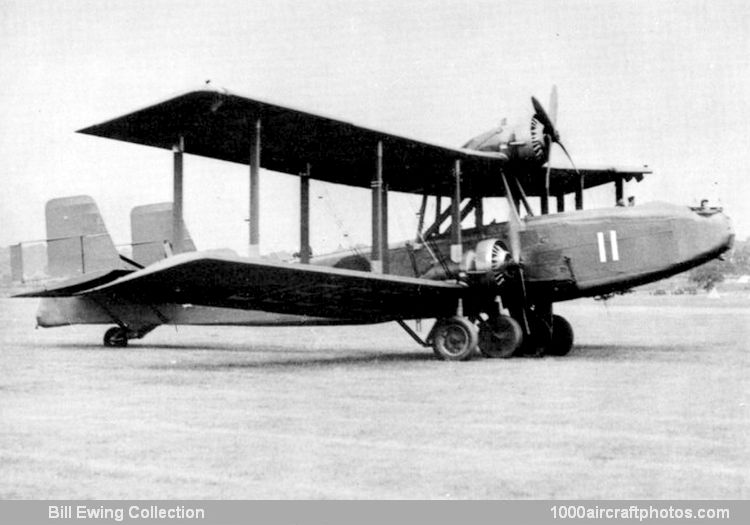08/31/2011. Remarks by Johan Visschedijk: "Two large biplanes of unusual layout, as far as British techniques in power arrangement were concerned, emanated in 1931 from Boulton & Paul and de Havilland as a result of the companies' tenders to Specification B.22/27, which was drawn up to produce a four-seat, long-range, heavy night bomber.
The 100 ft (30.48 m) span P.32, which John North designed for Boulton & Paul, left no doubt in the mind as to its ancestry, as, in the refined line of its fuselage and the square-cut planform of the three-bay, staggered, folding wings, it was obviously a near descendant of the Sidestrand. The most significant and unusual feature-possessed in common by both the P.32 and its rival, the de Havilland D.H.72, was the use of three tractor engines, the location of the third being in the center of the upper mainplanes.
The P.32's structure in the main followed that adopted for the Sidestrand using a metal airframe covered with fabric, the broad span dictating folding of the wings to 47 ft 6 in (12.95 m). The upper center section was straight, but that of the lower wings was given anhedral. The use of very long diagonal axles in each of the twin, divided landing gear units resulted in an unusually wide gap between the two wheels on each side. The P.32 was protected by three machine gun positions in the fuselage-nose, dorsal and rear-Scarff rings carrying those in the front and middle.
The three engines were of the same type, the Bristol Jupiter XF, but were subsequently exchanged for medium-supercharged 575 hp Jupiter XFBMs surrounded by Townend rings which incorporated exhaust collectors. The pair of Jupiters flanking the fuselage were installed direct on the lower wings, and all three drove four-blade propellers. Each of the twin rudders was equipped with a smaller servo surface outrigged on struts to its rear.
Serialed J9950, the P.32 eventually made its first take off in January, 1931, from Mousehold piloted by Sqn. Ldr. C.A. Rea. At this period in bomber evolution it was still possible, and often the custom, for a prototype to be constructed in a relatively short time, but, in the case of the P.32, the gestation was considerably longer than had been intended, owing to continued uncertainty over the power plant to be used. The choice had fallen on a Bristol air-cooled type with the Jupiter VIII, Mercury V, later to be developed into the Pegasus, and the Jupiter X investigated in turn.
Often, when more than one prototype was built to a specific requirement, the resulting aircraft from different concerns were of totally dissimilar concept to perform the same tasks. At other times designers would arrive at the same conclusions for the optimum layout, and their creations would be strikingly alike in size and appearance. The two B.22/27 prototypes demonstrated this similarity, and the P.32's competitor from de Havilland resembled closely the Boulton & Paul product but lacked the elegance of fuselage line possessed by the P.32.
Work on the D.H.72 was started at Stag Lane in 1928, and the machine was designed to have an all-metal airframe. So far the firm's experience had been mainly with wooden structures, and the new venture proceeded at a very slow rate at the Edgware works until, finally, the partly constructed biplane was transferred to the Gloster factory at Brockworth for completion under the s/n J9184.
At the time when the D.H.72 was conceived Jupiter VI power plants were decided upon, but, as the months passed, improved versions of the Jupiter were scheduled until, upon completion for its maiden flight in 1931, three uncowled Jupiter XFS engines, driving four-blade propellers, were installed. In common with the P.32, the 95 ft (28.96 m) equal-span, three-bay wings folded out-board of the straight center section. Gunners' cockpits occupied each end of the fuselage, on the underside of which bombs could be stowed in external racks. The D.H.72's upper and lower ailerons were connected by a pair of struts on each side, and the machine's main landing gear consisted of twin wheels beneath each of the wing-mounted engines.
Despite the application of several years of design and construction effort to produce the massive P.32 and D.H.72, the Air Ministry's plans changed, and the requirement was abandoned; the P.32 ended its days at Martlesham following a public appearance at the 1932 Hendon Air Display."
